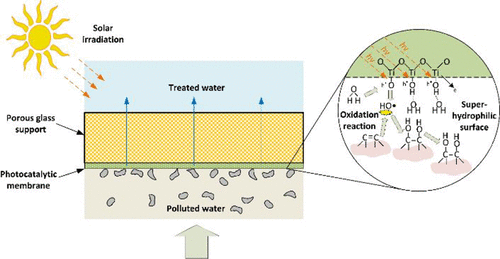当前位置:
X-MOL 学术
›
ACS ES&T Water
›
论文详情
Our official English website, www.x-mol.net, welcomes your
feedback! (Note: you will need to create a separate account there.)
Sunlight-Transmitting Photocatalytic Membrane for Reduced Maintenance Water Treatment
ACS ES&T Water ( IF 4.8 ) Pub Date : 2021-08-10 , DOI: 10.1021/acsestwater.1c00073 Lavern T. Nyamutswa 1 , Blair Hanson 2 , Dimuth Navaratna 1, 3 , Stephen F. Collins 3 , Karl G. Linden 2 , Mikel C. Duke 1
ACS ES&T Water ( IF 4.8 ) Pub Date : 2021-08-10 , DOI: 10.1021/acsestwater.1c00073 Lavern T. Nyamutswa 1 , Blair Hanson 2 , Dimuth Navaratna 1, 3 , Stephen F. Collins 3 , Karl G. Linden 2 , Mikel C. Duke 1
Affiliation

|
Membranes remove contaminants from drinking water but require routine cleaning with harsh chemicals that are less conveniently accessed, handled, and disposed of in remote communities. This work demonstrates a nonchemical solar cleaning alternative using simulated sunlight that has been conveniently directed through a light-transmitting porous glass substrate to a thin TiO2 photocatalytic membrane coating. Dead-end filtration of nonpotable water with routine chemical-free backwashing showed the solar cleaning provided a 4.5-fold extension to the time needed before a chemical clean, as well as a 50% reduction in filtration pump electricity demand. These improvements were attributed to formation of hydroxyl radicals and subsequent oxidation of organic foulants, as well as the well-known photocatalytic superhydrophilic surface stimulation of TiO2 surfaces. Both effects acted together to reduce irreversible surface attachment of organic foulants. Size exclusion chromatography (SEC) indicated the effect only targeted the organic molecule–membrane surface interaction as little change was observed in the bulk organics profiles. Substrate light transmission onto photocatalytic membrane surfaces demonstrated in this work could be successfully applied as a membrane cleaning method during water treatment in remote communities. Future explorations can be made into potential for enhanced disinfection and antifouling functions on wider ranges of organic contaminated water supplies.
中文翻译:

用于减少维护水处理的阳光透射光催化膜
膜可以去除饮用水中的污染物,但需要使用刺激性化学物质进行常规清洁,而这些化学物质在偏远社区不太容易获得、处理和处置。这项工作展示了一种使用模拟阳光的非化学太阳能清洁替代方案,该阳光已方便地通过透光多孔玻璃基板引导至薄 TiO 2光催化膜涂层。使用常规无化学反冲洗对非饮用水进行死端过滤表明,太阳能清洁使化学清洁前所需的时间延长了 4.5 倍,并且过滤泵的电力需求减少了 50%。这些改进归因于羟基自由基的形成和随后有机污染物的氧化,以及众所周知的 TiO 2光催化超亲水表面刺激表面。两种效应共同作用以减少有机污染物的不可逆表面附着。尺寸排阻色谱 (SEC) 表明该效应仅针对有机分子 - 膜表面相互作用,因为在本体有机物谱中观察到的变化很小。在这项工作中证明的光催化膜表面上的基材光传输可以成功地应用于偏远社区水处理过程中的膜清洁方法。未来可以探索在更广泛的有机污染水源上增强消毒和防污功能的潜力。
更新日期:2021-09-10
中文翻译:

用于减少维护水处理的阳光透射光催化膜
膜可以去除饮用水中的污染物,但需要使用刺激性化学物质进行常规清洁,而这些化学物质在偏远社区不太容易获得、处理和处置。这项工作展示了一种使用模拟阳光的非化学太阳能清洁替代方案,该阳光已方便地通过透光多孔玻璃基板引导至薄 TiO 2光催化膜涂层。使用常规无化学反冲洗对非饮用水进行死端过滤表明,太阳能清洁使化学清洁前所需的时间延长了 4.5 倍,并且过滤泵的电力需求减少了 50%。这些改进归因于羟基自由基的形成和随后有机污染物的氧化,以及众所周知的 TiO 2光催化超亲水表面刺激表面。两种效应共同作用以减少有机污染物的不可逆表面附着。尺寸排阻色谱 (SEC) 表明该效应仅针对有机分子 - 膜表面相互作用,因为在本体有机物谱中观察到的变化很小。在这项工作中证明的光催化膜表面上的基材光传输可以成功地应用于偏远社区水处理过程中的膜清洁方法。未来可以探索在更广泛的有机污染水源上增强消毒和防污功能的潜力。











































 京公网安备 11010802027423号
京公网安备 11010802027423号